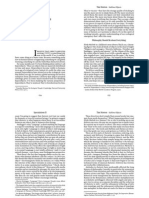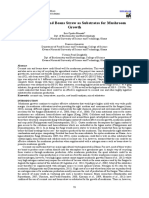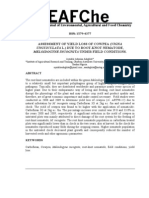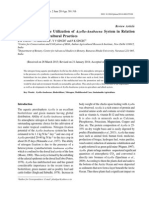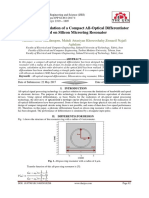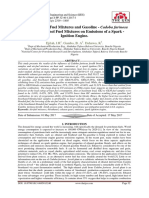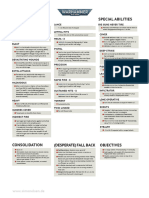Dynamics Growth of Soybeans in Agroforestry System With Fertilization of N, P, Micro Nutrient and Organic Manure
Dynamics Growth of Soybeans in Agroforestry System With Fertilization of N, P, Micro Nutrient and Organic Manure
Uploaded by
theijesCopyright:
Available Formats
Dynamics Growth of Soybeans in Agroforestry System With Fertilization of N, P, Micro Nutrient and Organic Manure
Dynamics Growth of Soybeans in Agroforestry System With Fertilization of N, P, Micro Nutrient and Organic Manure
Uploaded by
theijesOriginal Title
Copyright
Available Formats
Share this document
Did you find this document useful?
Is this content inappropriate?
Copyright:
Available Formats
Dynamics Growth of Soybeans in Agroforestry System With Fertilization of N, P, Micro Nutrient and Organic Manure
Dynamics Growth of Soybeans in Agroforestry System With Fertilization of N, P, Micro Nutrient and Organic Manure
Uploaded by
theijesCopyright:
Available Formats
The International Journal of Engineering And Science (IJES) ||Volume|| 2 ||Issue|| 7 ||Pages|| 78-82 ||2013|| ISSN: 2319 1813
3 ISBN: 2319 1805
Dynamics Growth of Soybeans in Agroforestry System with Fertilization of N, P, Micro Nutrient and Organic Manure
1
Supriyadi, 2Djoko Purnomo, 3Galih Kusumaningrum
Department of Soil Science, Sebelas Maret University 2 Department of Agronomy, Sebelas Maret University 3 Department of Agrotechnology, Sebelas Maret University
1
--------------------------------------------------------ABSTRACT----------------------------------------------------------Soybean is one of agriculture commodity which have many of function and have cultivated by farmers. But one of constraint soybean cultivate is decreasing agriculture farm caused displacing farm function, to overcome this farmers in Gunung Gajah, Cawas, Klaten applied agroforestry system. Agroforestry assesed as one of alternative agriculture system to overcome fast height agriculture farm conversion. The aim of the research was to study the fertilization on soybean, specifying appropriate varietas for the system of agroforestry, and specify requirement of hara of organic and inorganic manure of local resource in organic conducting o] soy crop in farm of agroforestry. The experiment was conducted in inceptisol soil arranged in group randomized device factorial design with factor 1: soy varietas ( Grobogan and of Kaba), and factor 2: manure ( inorganic manure and inorganic manure + organic), every re-treatment combination 3 times. Result of research indicate that wide index leaf, wide of specific leaf, and unit rate leaf not yet optimal and affect at result produce that is biomassa which still under standart that is 98,49 g /m2.
KEYWORDS - soybean, agroforestry, inorganic fertilizer, organic fertilizer specific location, biomassa --------------------------------------------------------------------------------------------------------------------------------------I. INTRODUCTION
Soybeans is one of agriculture commodity which have many of function. People usually consume soybeans directly as boiled soybean or use soybean as basic material on agroindustry like fermented soybean cake (tempe), tofu, tauco, soy sauce, soya milk, and as basic material for livestock food. As one of plant which contains protein, soybeans need a lot of nutrient, especially nitrogene (N) and phosphorus (P). Many of soybean have cultivated on protection forest that is forest area which considered as area for save the ecological function, although that area not the precise area as cultivate area. But one of constraint soybean cultivate is decreasing agriculture farm caused displacing farm function, to overcome this farmers in Gunung Gajah, Cawas, Klaten applied agroforestry system. Agroforestry assesed as one of alternative agriculture system to overcome fast height agriculture farm conversion. Beside for save the ecological function, protection forest area have economical function that is for cultivated soybeans, with combination between soybeans with the trees which have high leaf and have deep root system to decrease the competition. But the problems for agroforestry system is have low nutrient on soil, soybeans which cultivated cant optimal grow and produce empty of legumes of various. Constraint from cultivated on protection forest Gunung Gajah was high amount of empty legume various. Empty legume various with fertilization nitrogene (N), phosphorus (P), molybdenum (Mo), and magnesium (Mg). That was need to stable using organic manure specific on location, [1].
II. RESEARCH METHOD
The research start on July 2011 to November 2011, location on Gunung Gajah village, Cawas, Klaten. Situated at 1100 39 9.54 longitude east and 70 45 8.77 southern longitude, on altitude between 550 -590 m above the sea level (m dpl), with inceptisols. The laboratorium analysis like measure biomass plants do on Ekologi and Manajemen Produksi Tanaman (EMPT), Agriculture Faculty, Sebelas Maret University. The materials are soybean seed Grobogan and Kaba variety, organic fertilizer, micro nutrient, urea fertilizer, and phospat fertilizer. The equipment use like equipment for soil cultivate, analytic scales, lighmeter, thermometer, oven, handsprayer, and perforator. The aim of the research was to study the fertilization on soybean, specifying appropriate varietas for the system of agroforestry, and specify requirement of hara of organic and inorganic manure of local resource in
www.theijes.com
The IJES
Page 78
Preparation of Papers for the International Journal of Engineering and Science
organic conducting o] soy crop in farm of agroforestry. The experiment was conducted in inceptisol soil arranged in group randomized device factorial design with factor 1: soy varietas ( Grobogan and of Kaba), and factor 2: manure ( inorganic manure and inorganic manure + organic), every re-treatment combination 3 times. Research start with cultivated soybean and monitoring variable like leaf area index, specific leaf area, leaf unit value, biomass, amount of nodule, amount of legume various, and biomass legume of various.
III. RESULT 1. Leaf Characteristic 1.1 Leaf Area Index The research showed that application on inorganic fertilizer have a higher leaf area index than inorganic and organic manure that is 0.73 : 0.34 for Grobogan variety and 0.58 : 0.35 for Kaba variety. (Under hardwood tree (jati;teak) or pine tree, soybeans have low leaf area index that is 1.1-1.8, [1]). Relationship between leaf area index and light interception is leaf area index = 1, 3.3 and 4.3 have light interception about 50, 90 and 95% [2]. For this research have light interception 67.96% which showed that the leaf area index must be larger than 1, but this result not optimalized. Larger leaf area index showed that larger light interception have accepted, and contributed to photosynthesis.
Fig. 1. Histogram of Leaf Area Index on 20 and 60 day with different application of fertilizer
Fig 2. Histogram of Leaf Area Index on 20 and 60 day with different variety (Grobogan and Kaba) 1.2 Specific Leaf Area Specific leaf area use to study the leaf thickness which showed the chloropil content and protein to formation a wide of leaf. Specific leaf area on age 20 and 60 day is 3.925 cm2/g and 4.74 cm2/g. The specific leaf area higher with inorganic fertilizer application, from 3.49 to 5.16 cm2/g. But with inorganic and organic manure application showed the constant of specific leaf area that is 4.66 cm2/g. Specific leaf area will be low when the leaf accept low light interception, on low light interception leaf can strengthen.
www.theijes.com
The IJES
Page 79
Preparation of Papers for the International Journal of Engineering and Science
Fig 3. Histogram of Specific Leaf Area on 20 and 60 day with different application of fertilizer
Fig 4. Histogram of Specific Leaf Area on 20 and 60 day with different variety (Grobogan and Kaba) 1.3 Unit Rate Leaf Unit rate leaf is ability from leaf to produce biomass from [3]. Unit rate leaf soybean on age 20 and 60 day was 1.90 and 2.22 g/cm2 for Kaba variety. For Grobogan variety was 2.13 and 2.68 g/cm 2. Based on Fig 5., inorganic fertilizer application increasing unit rate leaf.
Fig 5. Histogram of Unit Rate Leaf on 20 and 60 day with different application of fertilizer
Fig 6. Histogram of Unit Rate Leaf on 20 and 60 day with different variety (Grobogan and Kaba) www.theijes.com The IJES Page 80
Preparation of Papers for the International Journal of Engineering and Science
2. Nodule of Legume Various Nodule was a part of legume plant use for symbiosis between root and the held nitrogene bacteria that is Rhizobium, who can fixation N direct from air, and use it to completed nitrogene needed by plant from fixation N2 [4]. The research showed that nodule on Kaba variety better than Grobogan variety on fertilizer application. It is identification that Kaba can absorp nutrient better than Grobogan. Beside that characteristic from organic manure that is slow release, can absorp by plant which have long age about 80 day, but age of Grobogan just 76 days, and Kaba 85 days [5].
Fig 7. Histogram Nodule of Legume when harvesting between two variety (Grobogan and Kaba) with different application fertilizer
3. Biomass Biomass made from result of photosynthesis (photosyntat) organized as carbohydrate which use to grow and development plant. Soybeans plant biomass increasing along with add of age (Fig 8). This is cause of more higher accumulation of photosyntat. Soybeans biomass on age 20, 40, 60, and harvest was 0.57 g, 1.97 g, 6.15 g, and 9.17 g. On this research biomass about 98.49 g/m 2, wereas usually soybeans biomass about 120-175 g/m2 [6].
Fig 8. Histogram of Biomassa on 20, 40, 60 day and harvest with different application of fertilizer
Fig 9. Histogram of Biomassa on 20, 40, 60 day and harvest with different variety (Grobogan and Kaba) www.theijes.com The IJES Page 81
Preparation of Papers for the International Journal of Engineering and Science
4. Production Component (Amount of Legume Various) Kaba has many legume various than Grobogan with percentage 60.71% : 39.39% (Fig 10). Amount of legume various from this research in great quantities (25-50 various every plant), but that legume various was empty. Based on research soybeans need nitrogene 60 kg to production 1 ton of soybeans with 1 hectare area, wereas nitrogene added 40 kg from organic manure (goat manure) and 23 kg from urea fertilizer. But nitrogene will be lost about 25%, and amount of available nitrogene about 47.25 kg causing plant deficiency nitrogene nutrient about 12.75 kg (look enclosure) [7]. Deficiency nitrogene will decreasing photosyntat, then will decreasing food for make a seed and resulted empty legume various. Decreasing photosyntat have a correlation with magnesium (Mg) nutrient. On this research magnesium (Mg) nutrient didnt enough, less 3.99 kg (look enclosure). Magnesium nutrient have the function to make chloropil, chloropil use on photosynthesis. Decrease magnesium nutrient will decreasing photosynthesis rate and decrease photosyntat. It will consequence empty legume various.
Fig 10. Histogram of amount of legume various when harvesting with different variety (Grobogan and Kaba) and different fertilizer application
IV. CONCLUSION
1. Organic manure application didnt decreasing amount of empty legume various. 2. Grobogan variety appropriate to cultivate on agroforestry system. 3. Inorganic manure needed on soybeans cultivate with composition 75 kg/Ha urea, 100 kg/Ha SP36, 1.5 l/Ha micro manure contains magnesium and sulphur, and organic fertilizer 5 ton/Ha.
ACKNOWLEDGEMENTS
On this occasion, the authors express gratitude to the Directorate General for Higher Education (DIKTI) of the Indonesian Ministry for National Education in which budget for this research.
REFERENCES
[1] Purnomo, D., Suryono, Triyono, dan Supriyadi, Potensi Seresah Berbagai Pohon Mengandung Tannin Dalam Sistem Agroforestri Berbasis Eucalyptus dan Gmelina Sebagai Penghambat Nitrifikasi Guna Peningkatan Efisiensi Pemupukan N, Journal Agrivita Vol. 31, 2009. Sinclair, T. R., and F. P. Gardner, Principles of Ecology In Plant Production (USA: University of Florida, 1998). Sitompul dan Guritno, Analisis Pertumbuhan Tanaman (Yogyakarta: Gadjah Mada University Press, 1995). Foth, H. D, Dasar-Dasar Ilmu Tanah (Jakarta: Erlangga, 1994). Suhartina, Deskripsi Varietas Unggul Kacang-kacangan dan Umbi-umbian ( Bogor: Balai Penelitian Kacang-kacangan dan Umbiumbian, 2005). Guritno, B, dan D. Purnomo, Tanggapan Varietas Tanaman Kedelai Terhadap Irradiasi Rendah; Agrosains Vol 8, 2006 Dierolf, T., Thomas F., and E. Mutert, A Toolkit For Acid, Upland Soil Fertility Management In Southeast Asia ( 2001)
[2] [3] [4] [5] [6] [7]
www.theijes.com
The IJES
Page 82
You might also like
- Morton - Sublime ObjectsDocument11 pagesMorton - Sublime ObjectsAm LewNo ratings yet
- Cultivation of Pleurotus Sajor-Caju On Different Agro WastesDocument4 pagesCultivation of Pleurotus Sajor-Caju On Different Agro WastesTabishNo ratings yet
- AGRONOMYDocument7 pagesAGRONOMYDreamAgriNo ratings yet
- Influence of Different Substrates On Growth and Yield Of: Pleurotus OstreatusDocument5 pagesInfluence of Different Substrates On Growth and Yield Of: Pleurotus OstreatusShailendra RajanNo ratings yet
- Partisi Fotosintat Beberapa Kultivar Ked 5dcc2488Document8 pagesPartisi Fotosintat Beberapa Kultivar Ked 5dcc2488Sanekala SenjaNo ratings yet
- Maheswari227 82020PCBMB8536Document7 pagesMaheswari227 82020PCBMB8536pennylanecortez12No ratings yet
- Noerwijati - 2023 - IOP - Conf. - Ser. - Earth - Environ. - Sci. - 1246 - 012001Document12 pagesNoerwijati - 2023 - IOP - Conf. - Ser. - Earth - Environ. - Sci. - 1246 - 012001kartika noerwijatiNo ratings yet
- Cowpeaintercroping PDFDocument11 pagesCowpeaintercroping PDFhlaxNo ratings yet
- Cowpeaintercroping PDFDocument11 pagesCowpeaintercroping PDFhlaxNo ratings yet
- Paper 1Document8 pagesPaper 1jthairu93.jtNo ratings yet
- Comparative Study On The Phenology and Yield Components of Two Photoperiodic Groups of Cowpea ManggoelDocument10 pagesComparative Study On The Phenology and Yield Components of Two Photoperiodic Groups of Cowpea ManggoelMadjokfaOscarNo ratings yet
- Ijaer 05 29Document9 pagesIjaer 05 29dantepepitodiazjr2005No ratings yet
- Productivity of Tomato (Lycopersicon Esculentum L) As Influenced by Spacing and Cow Dung Manure in The Sudan Savann Ahagro-Ecological Zone of NigeriaDocument9 pagesProductivity of Tomato (Lycopersicon Esculentum L) As Influenced by Spacing and Cow Dung Manure in The Sudan Savann Ahagro-Ecological Zone of Nigerialsijjournal456No ratings yet
- Jimb 1353Document10 pagesJimb 1353oharaamelia8No ratings yet
- Ravshanova 2020 IOP Conf. Ser. Earth Environ. Sci. 614 012126Document10 pagesRavshanova 2020 IOP Conf. Ser. Earth Environ. Sci. 614 012126sannthymNo ratings yet
- 111418158 MesfinDocument12 pages111418158 Mesfinmihiretu mulunehNo ratings yet
- Response of Maize Productivity To Nitrogen Fertilizer and Spraying With Blue Green Algae Extract - IJAARDocument11 pagesResponse of Maize Productivity To Nitrogen Fertilizer and Spraying With Blue Green Algae Extract - IJAARInternational Network For Natural SciencesNo ratings yet
- Growth and Yield of Okra 2nd DraftDocument17 pagesGrowth and Yield of Okra 2nd DraftSaheden SalilawanNo ratings yet
- Journal Homepage: - : IntroductionDocument11 pagesJournal Homepage: - : IntroductionIJAR JOURNALNo ratings yet
- A Comparison of Cabbage Crop Growth Parameters and Harvest Maturity Indices Under Different Planting Methods, With An Emphasis On Mechanical HarvestingDocument5 pagesA Comparison of Cabbage Crop Growth Parameters and Harvest Maturity Indices Under Different Planting Methods, With An Emphasis On Mechanical HarvestingShailendra RajanNo ratings yet
- Institute of Agricultural Science Bundelkhand University, Jhansi-284128 (U.P)Document9 pagesInstitute of Agricultural Science Bundelkhand University, Jhansi-284128 (U.P)Sachin MauryaNo ratings yet
- Performance of Popcorn Introductions For AgronomicDocument8 pagesPerformance of Popcorn Introductions For AgronomicDANIEL LEONARDO DE LA CRUZ GOMEZNo ratings yet
- tmpCF23 TMPDocument10 pagestmpCF23 TMPFrontiersNo ratings yet
- Exploring The Effect of Nitrogen Levels On Yield and Yield Attributes of Diverse Open-Pollinated Varieties (OPVs) of Maize (Zea Mays)Document8 pagesExploring The Effect of Nitrogen Levels On Yield and Yield Attributes of Diverse Open-Pollinated Varieties (OPVs) of Maize (Zea Mays)Advances in Agriculture and BiologyNo ratings yet
- 2023-SI-Azizi 2023 IOP Conf. Ser. Earth Environ. Sci. 1183 012090Document9 pages2023-SI-Azizi 2023 IOP Conf. Ser. Earth Environ. Sci. 1183 012090Bakhtiar BasyahNo ratings yet
- Bioconversion of Agro Forest Residues For Production of Oyster MushroomsDocument8 pagesBioconversion of Agro Forest Residues For Production of Oyster MushroomsIJEAB JournalNo ratings yet
- N. C. Aswathi, Et AlDocument9 pagesN. C. Aswathi, Et AlDillip Kumar PandaNo ratings yet
- PechayDocument3 pagesPechayLearma Mae PantiNo ratings yet
- AAST 2014 GC Final ResearchDocument30 pagesAAST 2014 GC Final ResearchSilas SimonNo ratings yet
- AGRO-3Document6 pagesAGRO-3siddu malakannavarNo ratings yet
- Coconut Coir and Beans Straw As Substrates For MushroomDocument7 pagesCoconut Coir and Beans Straw As Substrates For MushroomLily Khalidatussoleha Mohamad KhalidNo ratings yet
- Nutritional Evaluation of Spent and Uninoculated Mushroom Substrate of Pleurotus Ostreatus Grown On Cassava Peels and SawdustDocument6 pagesNutritional Evaluation of Spent and Uninoculated Mushroom Substrate of Pleurotus Ostreatus Grown On Cassava Peels and SawdustInternational Journal of Advances in Applied Sciences (IJAAS)No ratings yet
- Performance of Cotton VarietiesDocument21 pagesPerformance of Cotton VarietiesNasiru KuraNo ratings yet
- Quality Traits of SoybeanDocument9 pagesQuality Traits of SoybeanWaqas AhmadNo ratings yet
- Asn Paper 2017Document4 pagesAsn Paper 2017Nasiru KuraNo ratings yet
- Doi 15.1773 IJAB-20-1556Document9 pagesDoi 15.1773 IJAB-20-1556zishanNo ratings yet
- Final Dare Report 2024-25Document10 pagesFinal Dare Report 2024-25JIBAN MITRANo ratings yet
- Evaluation of Different Grains Used For ProductionDocument7 pagesEvaluation of Different Grains Used For ProductionAmin TaleghaniNo ratings yet
- Use of Lignocellulosic Corn and Rice Wastes As Substrates For Oyster Mushroom (Pleurotus Ostreatus Jacq.) CultivationDocument10 pagesUse of Lignocellulosic Corn and Rice Wastes As Substrates For Oyster Mushroom (Pleurotus Ostreatus Jacq.) CultivationJesus CristianNo ratings yet
- Char of Rice StrawDocument12 pagesChar of Rice StrawANKIT KUMARNo ratings yet
- Effect of Intercropping Wheat (Triticum Aestivum.l.) With Mustard (Brassica Juncea) On Yield and Economics Under Organic System of CultivationDocument6 pagesEffect of Intercropping Wheat (Triticum Aestivum.l.) With Mustard (Brassica Juncea) On Yield and Economics Under Organic System of CultivationMamta AgarwalNo ratings yet
- Comportamiento Agronómico y Composición Química de Diferentes Variedades de Amaranthus Caudatus.Document9 pagesComportamiento Agronómico y Composición Química de Diferentes Variedades de Amaranthus Caudatus.Zero GameNo ratings yet
- Unguiculata L.) Due To Root-Knot Nematode, Meloidogyne Incognita Under Field ConditionsDocument7 pagesUnguiculata L.) Due To Root-Knot Nematode, Meloidogyne Incognita Under Field ConditionsmucksoodganaieNo ratings yet
- PH for MushroomsDocument6 pagesPH for MushroomsMuhammad IshaqNo ratings yet
- 3rd DropDocument16 pages3rd DropJake SagadNo ratings yet
- Performance of Green Bean (Phaseolus Vulgaris L.) Varieties in Response To Poultry Manure in Sudan Savanna of Nigeria-IJRASETDocument9 pagesPerformance of Green Bean (Phaseolus Vulgaris L.) Varieties in Response To Poultry Manure in Sudan Savanna of Nigeria-IJRASETIJRASETPublicationsNo ratings yet
- 2454-Article Text-8029-1-10-20191022Document9 pages2454-Article Text-8029-1-10-20191022078 Medi Muhammad YusupNo ratings yet
- Advancements in The Bbutilization of Azolla Anabaena System in RelationDocument17 pagesAdvancements in The Bbutilization of Azolla Anabaena System in Relationryana_soesantieNo ratings yet
- Thesis Outline MasteralDocument16 pagesThesis Outline MasteralJenny Joy B. FortinNo ratings yet
- Growth and Yield Response of Okra To Organic and Inorganic Fertilizers On Degraded Upland Soil in Kori Chiefdom, Moyamba District, Sierra LeoneDocument7 pagesGrowth and Yield Response of Okra To Organic and Inorganic Fertilizers On Degraded Upland Soil in Kori Chiefdom, Moyamba District, Sierra LeoneInternational Journal of Recent Innovations in Academic ResearchNo ratings yet
- Response of Soybean Glycine Max L MerrilDocument22 pagesResponse of Soybean Glycine Max L Merrildawit gNo ratings yet
- Taro-LampakanDocument26 pagesTaro-Lampakangabutac aivlysNo ratings yet
- Extraction Productionof Agro Sackfrom Banana Musa Sapientum Plantain Musa Paradisiacal Fibresfor Packaging Agricultural ProduceDocument6 pagesExtraction Productionof Agro Sackfrom Banana Musa Sapientum Plantain Musa Paradisiacal Fibresfor Packaging Agricultural ProducegjhesraelNo ratings yet
- Journal of Experimental Biology and Agricultural Sciences: Suryantini and Henny KuntyastutiDocument8 pagesJournal of Experimental Biology and Agricultural Sciences: Suryantini and Henny KuntyastutiKim Angelo del CastilloNo ratings yet
- F7F34BCF4Document14 pagesF7F34BCF4MelakuNo ratings yet
- Plos OneDocument25 pagesPlos OneGhulam SarwarNo ratings yet
- Evaluation of Sucker Category For in Vitro Bud Proliferation and Genetic Association of Mother and Surrounding Suckers of Musa SPPDocument10 pagesEvaluation of Sucker Category For in Vitro Bud Proliferation and Genetic Association of Mother and Surrounding Suckers of Musa SPPScivision PublishersNo ratings yet
- An Evaluation of The Yield of Corn (Zea Mays L.) and Bean (Phaseolus Vulgaris) IntercropDocument5 pagesAn Evaluation of The Yield of Corn (Zea Mays L.) and Bean (Phaseolus Vulgaris) Intercrophaidhar grandeNo ratings yet
- FoliarDocument8 pagesFoliarjustine pepitoNo ratings yet
- A Compilation of Ligno-Cellulose Feedstock and Related Research for Feed, Food and EnergyFrom EverandA Compilation of Ligno-Cellulose Feedstock and Related Research for Feed, Food and EnergyNo ratings yet
- Plants From Pitlakes: An inventory of plants from the pitlakes of Eastern Coalfields, IndiaFrom EverandPlants From Pitlakes: An inventory of plants from the pitlakes of Eastern Coalfields, IndiaNo ratings yet
- Defluoridation of Ground Water Using Corn Cobs PowderDocument4 pagesDefluoridation of Ground Water Using Corn Cobs PowdertheijesNo ratings yet
- Development of The Water Potential in River Estuary (Loloan) Based On Society For The Water Conservation in Saba Coastal Village, Gianyar RegencyDocument9 pagesDevelopment of The Water Potential in River Estuary (Loloan) Based On Society For The Water Conservation in Saba Coastal Village, Gianyar RegencytheijesNo ratings yet
- Mixed Model Analysis For OverdispersionDocument9 pagesMixed Model Analysis For OverdispersiontheijesNo ratings yet
- Design and Simulation of A Compact All-Optical Differentiator Based On Silicon Microring ResonatorDocument5 pagesDesign and Simulation of A Compact All-Optical Differentiator Based On Silicon Microring ResonatortheijesNo ratings yet
- Influence of Air-Fuel Mixtures and Gasoline - Cadoba Farinosa Forskk Bioethanol Fuel Mixtures On Emissions of A Spark - Ignition Engine.Document9 pagesInfluence of Air-Fuel Mixtures and Gasoline - Cadoba Farinosa Forskk Bioethanol Fuel Mixtures On Emissions of A Spark - Ignition Engine.theijesNo ratings yet
- Sulfuric Acid Immobilized On Silica An Excellent Catalyst ForDocument5 pagesSulfuric Acid Immobilized On Silica An Excellent Catalyst ForJoseph HoffmanNo ratings yet
- Barren County High School Course Syllabus: AP Environmental Science SyllabusDocument8 pagesBarren County High School Course Syllabus: AP Environmental Science Syllabusshadab0123100% (2)
- Mentor Graphics Lab ManualDocument27 pagesMentor Graphics Lab ManualHavi KosuruNo ratings yet
- Ventriculoperitoneal Shunt Complications in Children An Evidence-Based Approach To Emergency Department Management PDFDocument24 pagesVentriculoperitoneal Shunt Complications in Children An Evidence-Based Approach To Emergency Department Management PDFGavin TexeirraNo ratings yet
- IC Fabrication TechnologyDocument5 pagesIC Fabrication TechnologyEldo N BabyNo ratings yet
- 095 Von Neumann ModelDocument4 pages095 Von Neumann Modelsoumilgupta2No ratings yet
- Skema Jawapan Instrumen Bi PTTS 2023Document9 pagesSkema Jawapan Instrumen Bi PTTS 2023AZIZAH BINTI ABAS KANJAT MoeNo ratings yet
- Alendronate SodiumDocument3 pagesAlendronate SodiumGLen Caniedo100% (1)
- Cerebellum & Brain-Stem AnatomyDocument23 pagesCerebellum & Brain-Stem AnatomyMuhammad ShahzaibNo ratings yet
- North Carolina COVID-19 Phase 2.5 of ReopeningDocument22 pagesNorth Carolina COVID-19 Phase 2.5 of ReopeningFOX8100% (1)
- HermeticDocument16 pagesHermetictzeianNo ratings yet
- 13 Strategies To Blast Brainfog EbookDocument23 pages13 Strategies To Blast Brainfog Ebookalbertoalberto_freeNo ratings yet
- Manual Combina Frigorifica Candy AlbaDocument230 pagesManual Combina Frigorifica Candy AlbaPerfectreviewNo ratings yet
- Manual Part LV IsuzuDocument1,285 pagesManual Part LV IsuzuJason Burton100% (1)
- Galaxy Rescue System Parachutes)Document42 pagesGalaxy Rescue System Parachutes)bahc1982No ratings yet
- Zerust - Product Catalog - Anti-RustDocument11 pagesZerust - Product Catalog - Anti-RustSon NguyenNo ratings yet
- Retromylohyiod FossaDocument14 pagesRetromylohyiod FossaSuman Bohra100% (2)
- Flexi Edge Bts UnitsDocument18 pagesFlexi Edge Bts Unitsthangnm100% (1)
- Seetah K. 2006. A Multidisciplinary Approach To Cattle Butchery-LibreDocument8 pagesSeetah K. 2006. A Multidisciplinary Approach To Cattle Butchery-LibreProciuc MarianaNo ratings yet
- VRLA Battery White Paper Final 1Document4 pagesVRLA Battery White Paper Final 1p41005679No ratings yet
- Proposed Pavilion Plan Technical DrawingsDocument5 pagesProposed Pavilion Plan Technical DrawingsLawrence TingNo ratings yet
- Unit 15 Family PlanningDocument184 pagesUnit 15 Family PlanningSamjhana NeupaneNo ratings yet
- Espresso: User ManualDocument16 pagesEspresso: User Manualcarlos siqueiraNo ratings yet
- Math 4 Matatag PPT q1 Week 1Document96 pagesMath 4 Matatag PPT q1 Week 1ruth danielle dela cruzNo ratings yet
- Weapons Training 1 (R4 Carbine)Document29 pagesWeapons Training 1 (R4 Carbine)Brent NavarozaNo ratings yet
- 40K SummaryDocument1 page40K Summary- MrTumnus1987No ratings yet
- PS - QP - IX - Eng - No Men Are ForeignDocument2 pagesPS - QP - IX - Eng - No Men Are Foreignparamveerbilakhiya1234No ratings yet
- Electrical Load ScheduleDocument3 pagesElectrical Load Schedulejayrick doctorNo ratings yet
- NRZIDocument19 pagesNRZIapi-3754722100% (1)
